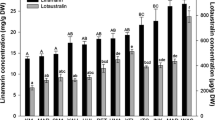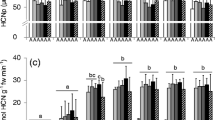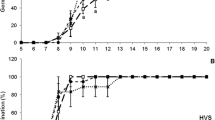Abstract
Main conclusion
Cyanogenic glycosides present in the seeds of wild lima bean plants are associated with seedling defense but do not affect seed germination and seedling growth.
Abstract
Wild lima bean plants contain cyanogenic glycosides (CNGs) that are known to defend the plant against leaf herbivores. However, seed feeders appear to be unaffected despite the high levels of CNGs in the seeds. We investigated a possible role of CNGs in seeds as nitrogen storage compounds that influence plant growth, as well as seedling resistance to herbivores. Using seeds from four different wild lima bean natural populations that are known to vary in CNG levels, we tested two non-mutually exclusive hypotheses: (1) seeds with higher levels of CNGs produce seedlings that are more resistant against generalist herbivores and, (2) seeds with higher levels of CNGs germinate faster and produce plants that exhibit better growth. Levels of CNGs in the seeds were negatively correlated with germination rates and not correlated with seedling growth. However, levels of CNGs increased significantly soon after germination and seeds with the highest CNG levels produced seedlings with higher CNG levels in cotyledons. Moreover, the growth rate of the generalist herbivore Spodoptera littoralis was lower in cotyledons with high-CNG levels. We conclude that CNGs in lima bean seeds do not play a role in seed germination and seedling growth, but are associated with seedling defense. Our results provide insight into the potential dual function of plant secondary metabolites as defense compounds and storage molecules for growth and development.






Similar content being viewed by others
References
Bak S, Kahn RA, Nielsen HL, Møller BL, Halkier BA (1998) Cloning of three A-type cytochromes P450, CYP71E1, CYP98, and CYP99 from Sorghum bicolor (L.) Moench by a PCR approach and identification by expression in Escherichia coli of CYP71E1 as a multifunctional cytochrome P450 in the biosynthesis of the cyanogen. Plant Mol Biol 36:393–405. https://doi.org/10.1023/A:1005915507497
Ballhorn DJ, Lieberei R (2006) Oviposition choice of Mexican bean beetle (Epilachna varivestis) depends on host plants cyanogenic capacity. J Chem Ecol 32:1861–1865. https://doi.org/10.1007/s10886-006-9114-z
Ballhorn DJ, Lieberei R, Ganzhorn JU (2005) Plant cyanogenesis of Phaseolus lunatus and its relevance for herbivore-plant interaction: the importance of quantitative data. J Chem Ecol 31:1445–1473. https://doi.org/10.1007/s10886-005-5791-2
Ballhorn DJ, Heil M, Pietrowski A, Lieberei R (2007) Quantitative effects of cyanogenesis on an adapted herbivore. J Chem Ecol 33:2195–2208. https://doi.org/10.1007/s10886-007-9380-4
Ballhorn DJ, Kautz S, Lion U, Heil M (2008a) Trade-offs between direct and indirect defences of lima bean (Phaseolus lunatus). J Ecol 96:971–980. https://doi.org/10.1111/j.1365-2745.2008.01404.x
Ballhorn DJ, Schiwy S, Jensen M, Heil M (2008b) Quantitative variability of direct chemical defense in primary and secondary leaves of lima bean (Phaseolus lunatus) and consequences for a natural herbivore. J Chem Ecol 34:1298–1301. https://doi.org/10.1007/s10886-008-9540-1
Ballhorn DJ, Kautz S, Heil M, Hegeman AD (2009) Cyanogenesis of wild lima bean (Phaseolus lunatus L.) is an efficient direct defence in nature. PLoS One 4:1–7. https://doi.org/10.1371/journal.pone.0005450
Barton KE, Koricheva J (2010) The ontogeny of plant defense and herbivory: characterizing general patterns using meta-analysis. Am Nat 175:481–493. https://doi.org/10.1086/650722
Bjarnholt N, Neilson EHJ, Crocoll C, Jørgensen K, Motawia MS, Olsen CE, Dixon DP et al (2018) Glutathione transferases catalyze recycling of auto-toxic cyanogenic glucosides in Sorghum. Plant J 94:1109–1125. https://doi.org/10.1111/tpj.13923
Boege K, Marquis RJ (2005) Facing herbivory as you grow up: the ontogeny of resistance in plants. Trends Ecol Evol 20:441–448. https://doi.org/10.1016/j.tree.2005.05.001
Brattsten LB, Samuelian JH, Long KY, Kincaid SA, Evans CK (1983) Cyanide as a feeding stimulant for the southern army worm, Spodoptera eridania. Ecol Entomol 8:125–132. https://doi.org/10.1111/j.1365-2311.1983.tb00490.x
Busk PK, Møller BL (2002) Dhurrin synthesis in Sorghum is regulated at the transcriptional level and induced by nitrogen fertilization in older plants. Plant Physiol 129:1222–1231. https://doi.org/10.1104/pp.000687
Clegg DO, Conn EE, Janzen DH (1979) Developmental fate of the cyanogenic glucoside linamarin in Costa Rican wild lima bean seeds. Nature 278:343–344
Cork SJ (1996) Sixth international theriological congress: optimal digestive strategies for arboreal herbivorous mammals in contrasting forest types: why Koalas and Colobines are different. Austral Ecol 21:10–20. https://doi.org/10.1111/j.1442-9993.1996.tb00581.x
Cuny MAC, Gendry J, Hernandez-Cumplido J, Benrey B (2018) Changes in plant growth and seed production in wild lima bean in response to herbivory are attenuated by parasitoids. Oecologia 187:447–457. https://doi.org/10.1007/s00442-018-4119-1
Dai J, Mumper RJ (2010) Plant phenolics: extraction, analysis and their antioxidant and anticancer properties. Molecules 15:7313–7352. https://doi.org/10.3390/molecules15107313
Del Cueto J, Ionescu IA, Pičmanová M, Gericke O, Motawia MS, Olsen CE, Campoy JA et al (2017) Cyanogenic glucosides and derivatives in almond and sweet cherry flower buds from dormancy to flowering. Front Plant Sci 8:1–16. https://doi.org/10.3389/fpls.2017.00800
Desurmont GA, Laplanche D, Schiestl FP, Turlings TCJ (2015) Floral volatiles interfere with plant attraction of parasitoids: ontogeny-dependent infochemical dynamics in Brassica rapa. BMC Ecol 15:1–11. https://doi.org/10.1186/s12898-015-0047-7
Dicenta F, Martínez-Gómez P, Grané N, Martín ML, León A, Cánovas JA, Berenguer V (2002) Relationship between cyanogenic compounds in kernels, leaves, and roots of sweet and bitter kernelled almonds. J Agric Food Chem 50:2149–2152. https://doi.org/10.1021/jf0113070
Dirzo R, Harper J (1982) Experimental studies on slug-plant interactions: IV. The performance of cyanogenic and acyanogenic morphs of Trifolium repens in the field. J Ecol 70(1):119–138. https://doi.org/10.2307/2259868
Engler-Chaouat HS, Gilbert LE (2007) De novo synthesis vs. sequestration: negatively correlated metabolic traits and the evolution of host plant specialization in cyanogenic butterflies. J Chem Ecol 33:25–42. https://doi.org/10.1007/s10886-006-9207-8
Ferreira C, Parra JRP, Terra WR (1997) The effect of dietary plant glycosides on larval midgut β-glucosidases from Spodoptera frugiperda and Diatraea saccharalis. Insect Biochem Mol Biol 27:55–59. https://doi.org/10.1016/S0965-1748(96)00069-0
Forslund K, Jonsson L (1997) Cyanogenic glycosides and their metabolic enzymes in barley, in relation to nitrogen levels. Physiol Plant 101:367–372. https://doi.org/10.1034/j.1399-3054.1997.1010217.x
Franks TK, Hayasaka Y, Choimes S, Van Heeswijck R (2005) Cyanogenic glucosides in grapevine: polymorphism, identification and developmental patterns. Phytochemistry 66:165–173. https://doi.org/10.1016/j.phytochem.2004.11.017
Frehner M, Conn EE (1987) The linamarin beta-Glucosidase in Costa Rican Wild lima beans (Phaseolus lunatus L.) Is Apoplastic. Plant Physiol 84:1296–1300. https://doi.org/10.1104/pp.84.4.1296
Frehner M, Scalet M, Conn EE (1990) Pattern of the cyanide-potential. Plant Physiol 94:28–34. https://doi.org/10.1104/pp.94.1.28
Gleadow RM, Woodrow IE (2000) Temporal and spatial variation in cyanogenic glycosides in Eucalyptus cladocalyx. Tree Physiol 20:591–598. https://doi.org/10.1093/treephys/20.9.591
Gleadow RM, Woodrow IE (2002) Constraints on effectiveness of cyanogenic glycosides in herbivore defense. J Chem Ecol 28:1301–1313. https://doi.org/10.1023/A:1016298100201
Godschalx AL, Stady L, Watzig B, Ballhorn DJ (2016) Is protection against florivory consistent with the optimal defense hypothesis? BMC Plant Biol 16:1–9. https://doi.org/10.1186/s12870-016-0719-2
Goodger JQD, Choo TYS, Woodrow IE (2007) Ontogenetic and temporal trajectories of chemical defence in a cyanogenic eucalypt. Oecologia 153:799–808. https://doi.org/10.1007/s00442-007-0787-y
Harborne JB, Williams CA (2000) Advances in flavonoid research since 1992. Phytochemistry 55:481–504. https://doi.org/10.1016/S0031-9422(00)00235-1
Heil M (2004) Direct defense or ecological costs: responses of herbivorous beetles to volatiles released by wild lima bean (Phaseolus lunatus). J Chem Ecol 30:1289–1295. https://doi.org/10.1023/B:JOEC.0000030299.59863.69
Hernandez-Cumplido J, Glauser G, Benrey B (2016) Cascading effects of early-season herbivory on late-season herbivores and their parasitoids. Ecology 97:1283–1297. https://doi.org/10.1890/15-1293.1/suppinfo
Jones D (1988) Cyanogenesis in animal–plant interactions. Ciba Found Symp 140:151–170
Jørgensen K, Morant AV, Morant M, Jensen NB, Olsen CE, Kannangara R, Motawia MS et al (2011) Biosynthesis of the cyanogenic glucosides linamarin and lotaustralin in cassava: isolation, biochemical characterization, and expression pattern of cyp71e7, the oxime-metabolizing cytochrome P450 enzyme. Plant Physiol 155:282–292. https://doi.org/10.1104/pp.110.164053
Kadow D, Voß K, Selmar D, Lieberei R (2012) The cyanogenic syndrome in rubber tree Hevea brasiliensis: tissue-damage-dependent activation of linamarase and hydroxynitrile lyase accelerates hydrogen cyanide release. Ann Bot 109:1253–1262. https://doi.org/10.1093/aob/mcs057
Kakes P (1990) Properties and functions of the cyanogenic system in higher plants. Euphytica 48:25–43. https://doi.org/10.1007/BF00028958
Kempel A, Schadler M, Chrobock T, Fischer M, van Kleunen M (2011) Tradeoffs associated with constitutive and induced plant resistance against herbivory. Proc Natl Acad Sci 108:5685–5689. https://doi.org/10.1073/pnas.1016508108
Köhler A, Maag D, Veyrat N, Glauser G, Wolfender JL, Turlings TCJ, Erb M (2015) Within-plant distribution of 1,4-benzoxazin-3-ones contributes to herbivore niche differentiation in maize. Plant Cell Environ 38:1081–1093. https://doi.org/10.1111/pce.12464
Lariviere A, Limeri LB, Meindl GA, Traw MB (2015) Herbivory and relative growth rates of Pieris rapae are correlated with host constitutive salicylic acid and flowering time. J Chem Ecol 41:350–359. https://doi.org/10.1007/s10886-015-0572-z
Lechtenberg M (2011) Cyanogenesis in higher plants and animals, eLS. Wiley, Chichester
Lieberei R, Selmar D, Biehl B (1985) Metabolization of cyanogenic glucosides in Hevea brasiliensis. Plant Syst Evol 150:49–63
Littell RC, Milliken GA, Stroup WW et al (2006) SAS for mixed models. SAS Institute, Cary, USA
Maag D, Erb M, Glauser G (2015a) Metabolomics in plant-herbivore interactions: challenges and applications. Entomol Exp Appl 157:18–29. https://doi.org/10.1111/eea.12336
Maag D, Erb M, Köllner TG, Gershenzon J (2015b) Defensive weapons and defense signals in plants: some metabolites serve both roles. Bioessays 37:167–174. https://doi.org/10.1002/bies.201400124
Malinovsky FG, Thomsen MLF, Nintemann SJ, Jagd LM, Bourgine B, Burow M, Kliebenstein DJ (2017) An evolutionarily young defense metabolite influences the root growth of plants via the ancient TOR signaling pathway. Elife 6:e29353. https://doi.org/10.7554/eLife.29353
Møller BL (2010) Functional diversifications of cyanogenic glucosides. Curr Opin Plant Biol 13:338–347. https://doi.org/10.1016/j.pbi.2010.01.009
Neilson EH, Goodger JQD, Motawia MS, Bjarnholt N, Frisch T, Olsen CE, Møller BL, Woodrow IE (2011) Phenylalanine derived cyanogenic diglucosides from Eucalyptus camphora and their abundances in relation to ontogeny and tissue type. Phytochemistry 72:2325–2334. https://doi.org/10.1016/j.phytochem.2011.08.022
Nielsen LJ, Stuart P, Pičmanová M, Rasmussen S, Olsen CE, Harholt J, Møller BL, Bjarnholt N (2016) Dhurrin metabolism in the developing grain of Sorghum bicolor (L.) Moench investigated by metabolite profiling and novel clustering analyses of time-resolved transcriptomic data. BMC Genom 17:1–24. https://doi.org/10.1186/s12864-016-3360-4
Ochoa-López S, Villamil N, Zedillo-Avelleyra P, Boege K (2015) Plant defence as a complex and changing phenotype throughout ontogeny. Ann Bot 116:797–806. https://doi.org/10.1093/aob/mcv113
Ochoa-López S, Rebollo R, Barton KE, Fornoni J, Boege K (2018) Risk of herbivore attack and heritability of ontogenetic trajectories in plant defense. Oecologia 187:1–14. https://doi.org/10.1007/s00442-018-4077-7
Pentzold S, Zagrobelny M, Rook F, Bak S (2013) How insects overcome two-component plant chemical defence: plant β-glucosidases as the main target for herbivore adaptation. Biol Rev 89:531–551. https://doi.org/10.1111/brv.12066
Pentzold S, Zagrobelny M, Bjarnholt N, Kroymann J, Vogel H, Olsen CE, Møller BL et al (2015) Metabolism, excretion and avoidance of cyanogenic glucosides in insects with different feeding specialisations. Insect Biochem Mol Biol 66:119–128. https://doi.org/10.1016/j.ibmb.2015.10.004
Pičmanová M, Neilson EH, Motawia MS, Olsen CE, Agerbirk N, Gray CJ, Flitsch S et al (2015) A recycling pathway for cyanogenic glycosides evidenced by the comparative metabolic profiling in three cyanogenic plant species. Biochem J 469:375–389. https://doi.org/10.1042/BJ20150390
Poulton JE (1988) Localization and catabolism of cyanogenic glycosides. Cyanide Compounds Biol 140:67–91
Rojas MG, Morales-Ramos JA (2010) Tri-trophic level impact of host plant linamarin and lotaustralin on Tetranychus urticae and its predator Phytoseiulus persimilis. J Chem Ecol 36:1354–1362. https://doi.org/10.1007/s10886-010-9872-5
Sánchez-Pérez R, Jørgensen K, Olsen CE, Dicenta F, Moller BL (2008) Bitterness in almonds. Plant Physiol 146:1040–1052. https://doi.org/10.1104/pp.107.112979
Sánchez-Pérez R, Jørgensen K, Motawia MS, Dicenta F, Møller BL (2009) Tissue and cellular localization of individual b-glycosidases using a substrate-specific sugar reducing assay. Plant J 60:894–906. https://doi.org/10.1111/j.1365-313X.2009.03997.x
Saunders JA, Conn EE (1978) Presence of the cyanogenic glucoside dhurrin in isolated vacuoles from Sorghum. Plant Physiol 61:154–157. https://doi.org/10.1104/pp.61.2.154
Schappert PJ, Shore JS (2000) Cyanogenesis in Turnera ulmifolia L. (Turneraceae): II. developmental expression, heritability and cost of cyanogenesis. Evol Ecol Res 2:337–352. https://doi.org/10.1038/hdy.1995.57
Schilcher VH, Wilkens-Sauter M (1986) Quantitative bestimmung cyanogener Glykoside in Linum usitatissimum mit Hilfe der HPLC. Fette Seifen Anstrichmittel 88:287–290
Schwarz B, Wray V, Proksch P (1996) A cyanogenic glycoside from Canthium schimperianum. Phytochemistry 42:633–636. https://doi.org/10.1016/0031-9422(96)00018-0
Scriber JM (1978) Cyanogenic glycosides in Lotus corniculatus—their effect upon growth, energy budget, and nitrogen utilization of the southern armyworm, Spodoptera eridania. Oecologia 34:143–155. https://doi.org/10.1007/BF00345163
Seigler DS (1998) Cyanogenic glycosides and cyanolipids. In: Seigler DS (ed) Plant secondary metabolism. Kluwer Academic Press, Boston, pp 273–296
Selmar D, Lieberei R, Biehl B, Nahrstedt A, Schmidtmann V, Wray V (1987) Occurrence of the cyanogen linustatin in Hevea brasiliensis. Phytochemistry 26:2400–2401. https://doi.org/10.1016/S0031-9422(00)84729-9
Selmar D, Lieberei R, Biehl B (1988) Mobilization and utilization of cyanogenic glycosides: the linustatin pathway. Plant Physiol 86:711–716. https://doi.org/10.1104/pp.86.3.711
Selmar D, Grocholewski S, Seigler DS (1990) Cyanogenic lipids: utilization during seedling development of Ungnadia speciosa. Plant Physiol 93:631–636. https://doi.org/10.1104/pp.93.2.631
Sendker J, Ellendorff T, Hölzenbein A (2016) Occurrence of benzoic acid esters as putative catabolites of prunasin in senescent leaves of Prunus laurocerasus. J Nat Prod 79:1724–1729. https://doi.org/10.1021/acs.jnatprod.5b01090
Shlichta JG, Glauser G, Benrey B (2014) Variation in cyanogenic glycosides across populations of wild lima beans (Phaseolus lunatus) has no apparent effect on bruchid beetle performance. J Chem Ecol 40:468–475. https://doi.org/10.1007/s10886-014-0434-0
Shlichta JG, Cuny MAC, Hernandez-Cumplido J, Traine J, Benrey B (2018) Contrasting consequences of plant domestication for the chemical defenses of leaves and seeds in lima bean plants. Basic Appl Ecol. https://doi.org/10.1016/j.baae.2018.05.012
Stauber EJ, Kuczka P, van Ohlen M, Vogt B, Janowitz T, Piotrowski M, Beuerle T et al (2012) Turning the “mustard oil bomb” into a “cyanide bomb”: aromatic glucosinolate metabolism in a specialist insect herbivore. PLoS One. https://doi.org/10.1371/journal.pone.0035545
Stensjo K, Jonsson L (1997) Cyanogenic glycosides and their metabolic enzymes in barley, in relation to nitrogen levels. Physiol Plant 101(367):372. https://doi.org/10.1111/j.1399-3054.1997.tb01010.x
Swain E, Poulton JE (1994) Utilization of amygdalin during seedling development of Prunus serotina. Plant Physiol 106:437–445. https://doi.org/10.1104/pp.106.2.437
Tanaka Y, Sasaki N, Ohmiya A (2008) Biosynthesis of plant pigments: anthocyanins, betalains and carotenoids. Plant J 54:733–749. https://doi.org/10.1111/j.1365-313X.2008.03447.x
Vassão DG, Wielsch N, de Gomes AM, Gebauer-Jung S, Hupfer Y, Svatoš A, Gershenzon J (2018) Plant defensive β-glucosidases resist digestion and sustain activity in the gut of a Lepidopteran herbivore. Front Plant Sci 9:1–13. https://doi.org/10.3389/fpls.2018.01389
Vetter J (2000) Plant cyanogenic glycosides. Toxicon 38:11–36. https://doi.org/10.1016/S0041-0101(99)00128-2
Yi H-S, Heil M, Adame-Alvarez RM, Ballhorn DJ, Ryu C-M (2009) Airborne induction and priming of plant defenses against a bacterial pathogen. Plant Physiol 151:2152–2161. https://doi.org/10.1104/pp.109.144782
Zagrobelny M, Bak S, Rasmussen AV, Jørgensen B, Naumann CM, Møller BL (2004) Cyanogenic glucosides and plant-insect interactions. Phytochemistry 65:293–306. https://doi.org/10.1016/j.phytochem.2003.10.016
Zagrobelny M, Bak S, Ekstrøm CT, Erik Olsen C, Møller BL (2007) The cyanogenic glucoside composition of Zygaena filipendulae (Lepidoptera: Zygaenidae) as effected by feeding on wild-type and transgenic lotus populations with variable cyanogenic glucoside profiles. Insect Biochem Mol Biol 37:10–18. https://doi.org/10.1016/j.ibmb.2006.09.008
Acknowledgements
We thank Ted Turlings and Adrienne Godschalx for their comments on an earlier version of this manuscript, and four anonymous reviewers for their many constructive comments that helped improved this manuscript. We also thank Martin Heil for many insightful discussions on lima bean that inspired some of this work. We are grateful to the Universidad del Mar of Puerto Escondido (Oaxaca, Mexico) for logistic support during fieldwork. This research was financially supported by the Swiss National Science Foundation (Project No. 3100AO-10923) awarded to BB.
Author information
Authors and Affiliations
Corresponding author
Ethics declarations
Conflict of interest
The authors declare that they have no conflict of interest.
Additional information
Publisher's Note
Springer Nature remains neutral with regard to jurisdictional claims in published maps and institutional affiliations.
Electronic supplementary material
Below is the link to the electronic supplementary material.
Rights and permissions
About this article
Cite this article
Cuny, M.A.C., La Forgia, D., Desurmont, G.A. et al. Role of cyanogenic glycosides in the seeds of wild lima bean, Phaseolus lunatus: defense, plant nutrition or both?. Planta 250, 1281–1292 (2019). https://doi.org/10.1007/s00425-019-03221-3
Received:
Accepted:
Published:
Issue Date:
DOI: https://doi.org/10.1007/s00425-019-03221-3




